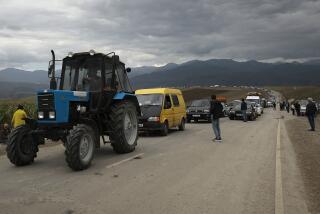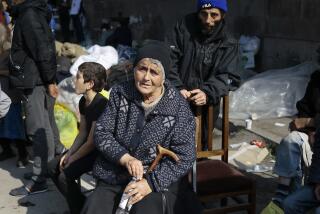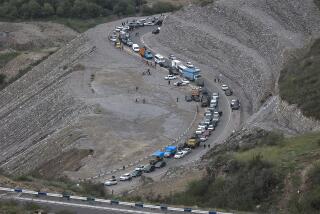Being Run Out, Armenians Charge : Soviet Union: They say Azerbaijanis are depopulating areas of the disputed enclave of Nagorno-Karabakh.
MOSCOW — Soviet Armenians on Saturday accused Azerbaijanis, their enemies in a bitter ethnic feud, of undertaking a cruel campaign to depopulate by force an area of Azerbaijan that has been peopled by Armenians for more than 1,500 years.
In the hilly region of Nagorno-Karabakh, 1,500 Armenians were allegedly uprooted at gunpoint from their homes in the Gadrut district by Azerbaijani police and deported to Goris in Armenia proper, Mikit Kazaryan of the Armenian government mission in Moscow charged.
Another 1,200 people--mostly women, children and the elderly--were forced to bivouac in an open field, where one woman gave birth, Kazaryan said. More than 500 adult men were taken hostage, the Armenian official asserted.
Azerbaijanis denied that there had been any use of violence or threats. But they acknowledged an outflow of Armenians from Nagorno-Karabakh, the contested region of Azerbaijan where three-quarters of the 180,000 inhabitants are ethnic Armenians.
“Six villages (three in Susha province and three in Gadrut) out of 160 Armenian villages have expressed their desire to change their places of residence. The rest are going to live here peacefully and in good-neighborly relations with Azerbaijanis,” the unofficial Assa-Irada press agency of Azerbaijan reported from Stepanakert, Nagorno-Karabakh’s administrative center.
Soviet authorities, meanwhile, accused Armenian “militants” of attacking a detachment of the Soviet Interior Ministry on the troubled Armenian-Azerbaijani border overnight.
In the village of Mor-Mor, Armenians equipped with submachine guns fired on Soviet troops, provoking return fire, the official Tass news agency reported. It said nothing about any casualties.
It was impossible to independently verify the Armenian claims of forced deportations, but the reports were rife. Elected officials in Nagorno-Karabakh, in an appeal for immediate assistance addressed to the United Nations, President Bush and other world leaders, said they are witnessing “a genocide of the Armenian population, carried out by the Soviet army jointly with the armed units of the Azerbaijani republic.”
“The scenario is well-established: The (Soviet) military encircles the village, and then the Azerbaijani OMON (special police) go in,” said Kamo Avanesyan, a spokesman for the pro-independence Armenian Union of National Self-Determination. “The police check passports, and everybody ‘suspicious’ --that means all males, from 16 to 80--are sent to Azerbaijan as hostages.
“The women are then given prepared forms to sign, saying they want to voluntarily be relocated to Armenia. Then buses pull up, and everybody is forced to ride to the Goris region,” Avanesyan said.
He said that two areas of Nagorno-Karabakh--Gadrut and Bertadzarsky--have been totally depleted of their Armenian population in the last three days.
Armenians reacted with shock and dismay to the reports because they consider Nagorno-Karabakh part of their historic motherland, despite its incorporation under Soviet power into Azerbaijan. In the year 470, the first Armenian school was founded in the region, and there are more than 100 monuments dating to the 5th and 6th centuries.
“Armenians have the full right to be considered as the native population,” Kazaryan said.
Levon M. Shakhnazarov, an official in Nagorno-Karabakh, said in an interview that the events of the last few days have prompted panic among the local Armenian population. “No deportation is necessary at the moment; it’s enough to let people leave (Nagorno-Karabakh). They’ll do it right away,” he said.
Shakhnazarov charged that more than 60 people have been arrested over the last three nights in Stepanakert, including Armenian legislator Hamlet Grigoryan. Armored personnel carriers are grinding through the streets, promising “there will be no deportation” but warning people against “confrontation,” he said.
Shakhnazarov asserted that in one instance, Armenian villagers from Aranchu and Dolanlar in the Gadrut district were herded into buses Saturday morning and taken to the Lachinsky region of Azerbaijan to serve as “live shields” to deter possible Armenian attacks.
As with most of the other reports, it was impossible to independently corroborate Shakhnazarov’s charges.
Commenting on the events, Paruir Airikyan, an Armenian nationalist who spent two years in exile in Glendale, Calif., after being expelled from the Soviet Union on charges of fomenting ethnic unrest, said the three-year-old Armenian-Azerbaijani conflict, originally sparked by a quarrel over which of the neighboring republics should administer Nagorno-Karabakh, has entered a new phase.
“This is no longer an interethnic conflict--this is a conflict between totalitarianism and democracy, where ethnic passions are being exploited by totalitarianism,” Airikyan said. “Moscow is using Azerbaijan as a weapon against Armenia.”
More to Read
Sign up for Essential California
The most important California stories and recommendations in your inbox every morning.
You may occasionally receive promotional content from the Los Angeles Times.










